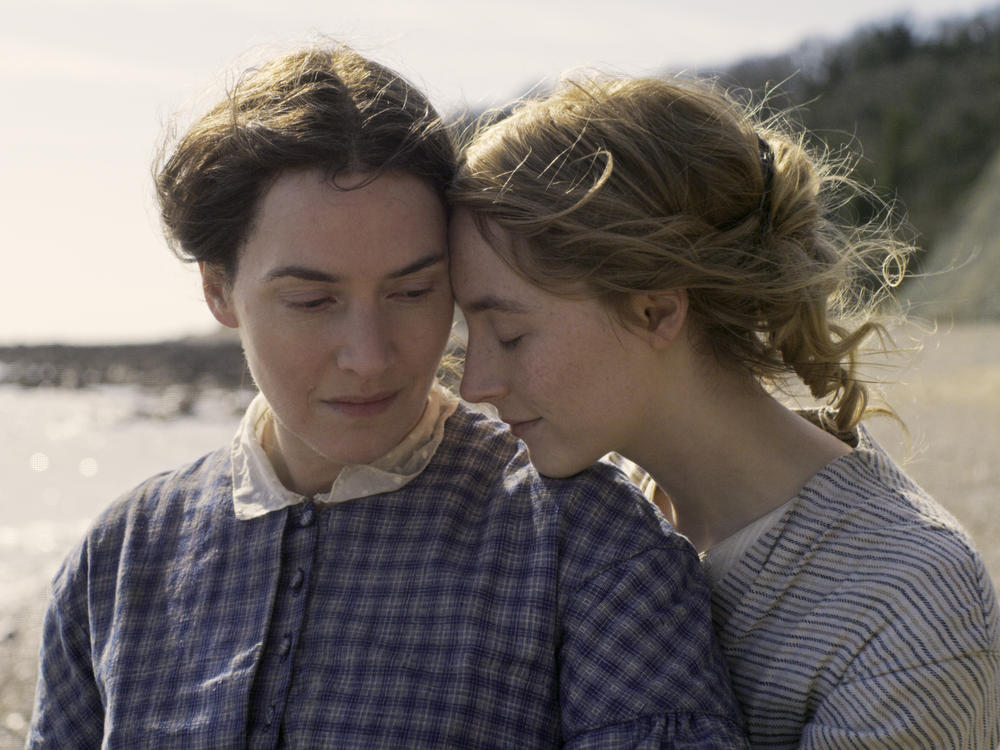Section Branding
Header Content
Heartbreaking And Hopeful, 'Ammonite' Is A Wind-Swept Tale Of Forbidden Love
Primary Content
Back in 2017, the English writer and director Francis Lee made a wrenching drama, called God's Own Country, that I wish more people had seen. It told the story of two isolated young men on the rugged moors of North Yorkshire, tending a flock of sheep and falling passionately in love — sort of like a British Brokeback Mountain, only a lot more explicit and with a much happier ending.
Now Lee has made another gorgeous wind-swept tale of forbidden love, this one set in the 1840s and centered on two women. It's called Ammonite, and it feels like a step up in scale and ambition, partly because it's about real-life figures, and partly because it stars Kate Winslet and Saoirse Ronan. But Lee's filmmaking is still as raw, intimate and unhurried as it was in God's Own Country. He takes his time easing you into his characters' world, which is important, since that world is not an easy place to live.
Winslet plays Mary Anning, a self-taught paleontologist who was known for her groundbreaking fossil discoveries along the shores and cliffs of Lyme Regis, a sleepy town in the English county of Dorset. The famous tongue-twister "She sells seashells by the seashore" is said to have been inspired by Anning, who sold many of her fossils, including those extinct mollusks known as ammonites.
Mary is gruff and solitary, a kind of human hermit crab, who lives with her ailing mother, played by Gemma Jones. One day, an aspiring geologist named Roderick Murchison turns up, offering to pay Mary if she'll let him accompany her on one of her fossil hunts. She reluctantly agrees, as she and her mother could use the money.
But Mary gets more than she bargained for. Roderick abruptly takes off and pays Mary to look after his young wife, Charlotte, for several weeks. Charlotte, played by Ronan, is suffering from severe depression following a miscarriage. And while Mary finds her burdensome at first, she nurses the poor woman back to health. A spark soon ignites, and the two begin to enjoy each other's company. Charlotte helps Mary with her work, which both fascinates and energizes her.
In some ways, Ammonite suggests a companion piece to Portrait of a Lady on Fire, another 19th-century lesbian love story set against a stark coastal landscape. Both films also make important points about the intellectual achievements of women and the way so many of them have been ignored and even erased by men throughout history. In the movie, some of Mary's most remarkable finds are displayed in museums under a man's name — a nod to the fact that Anning herself was often denied credit for her work.
Charlotte Murchison became a well-regarded geologist herself, and while she and Anning were close friends, it's unclear if they were really lovers. Ammonite is a free imagining of Mary's romantic life, and historical accuracy aside, it's gripping stuff: The erotic tension builds with such exquisite deliberation that when it finally erupts, the force of it practically shatters the screen. Ronan and Winslet give the sex scenes a startling physicality, which is fitting, since the entire film is so intensely physical. Lee's camera shows us a way of life sustained by nonstop manual labor: He's particularly attentive to the roughness of Mary's hands, whether she's preparing food, digging up rocks on the beach or sketching in her notebooks into the wee hours of the night.
There are fine supporting performances from Alec Secareanu as a charming village doctor, and from the great Fiona Shaw as a local apothecary who turns out to have some past romantic history with Mary. And Ronan is unsurprisingly good as Charlotte, whose love for Mary awakens in her a new sense of passion and purpose. But Ammonite really belongs to Winslet, who gives her richest performance in years. She makes Mary a profound study in alienation and loneliness, ill at ease with other people and deeply protective of her secrets.
In the end, it's telling that it's not neighborhood gossip or the stigma of homosexuality that threatens to keep these two women apart. It's Mary's need for control and her reluctance to let anyone into her carefully managed life. There's something heartbreaking about that, but something radically hopeful, too, as she and Charlotte circle the possibility of a future together. Ammonite may be set in the Victorian era, but it dares to envision a world in which women are ultimately free to make their own decisions, for themselves and for the ones they love.
Copyright 2020 Fresh Air. To see more, visit Fresh Air.
Bottom Content




